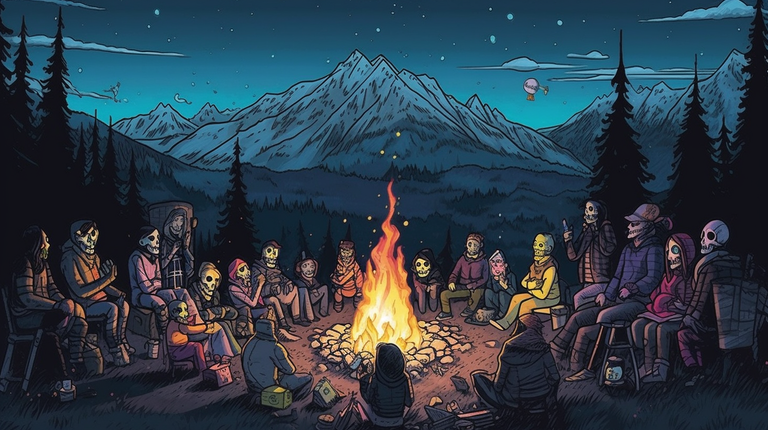Bonfire of the Vanities

The word of the day for Prompt A Day is ‘bonfires’. I had to close windows this morning as I realized the smoke from wildfires in Quebec had reached my area and was having an impact on my lungs. This is a new thing, I can never remember this happening in this area.
So, you’d expect writing about fire wouldn’t be catching my attention. But, you know, curiousity can be illogical. I decided to do some searching and exploring. I’m often curious about the story behind words. I don’t remember watching it, but I did remember the title of one movie as “Bonfire of the Vanities”. I’ll come back to that soon.
The word ‘bonfire’, you’d think with the French ‘bon’ present that it refers to a good fire. A 1755 dictionary gave that as a definition. The etymology was corrected in the 1890 Webster’s International Dictionary. First used in the late 1400s the word bonfire comes from the Middle English word ‘bonefire’. It literally means “a fire of bones”.
Significance of Burning Bones
In many early cultures burning the bones of people or animals was seen as the smoke and flames carrying prayers or messages to the spirit world or deities. Rituals and celebrations developed around this practice in many cultures.
Bones contain marrow and fats making them an excellent alternative fuel when other combustible materials were not in good supply. Also the heat generated from burning bones were more helpful in metalwork than the heat from sources like wood.
Over time the cultural practices became more about the bonfire than the bones.
Cultural Uses of Bonfires
Within the Christian faith bonfires are traditionally used to celebrate John the Baptist on June 24th. In Quebec, Canada this also occurs, under the name of Jean Baptiste Day which is a provincial holiday.
- Celtic cultures make use bonfires for the festival of Beltane to mark the start of the summer season.
- The Norse used bonfires for protective aspects of Midsummer as well as celebrations and feasts.
- Among the hundreds of North American Indigenous tribes bonfires were used for spiritual ceremonies and social activities. The rituals and purposes were many and varied across the tribes.
- In India bonfires are associated with festivals and rituals in different regions. The purpose of them are varied depending on the region.
- In the Slavic cultures Kupala Day bonfires were part of fertility and purification rituals while other groups bonfires are for celebration and entertainment.
- In culturally rich and diverse Africa many use bonfires as part of their cultures.
Fire, especially controlled fire can be cleansing and signal renewal. It’s no wonder their use has been so broadly embraced. The cultures I’ve named here are just an example of the many around the world that use bonfires as part of their observances.
Bonfire of the Vanities History
Many are familiar with the 1990 movie, which wasn’t exactly a box office hit. The movie was based on the bestselling book by the name written by Tom Wolfe in 1987. The book is a drama about ambition, racism, politics and greed in 1980s New York. Themes that could be written about just any era in modern society or sooner.
The original ‘bonfire of the vanities’ took place on February 7, 1497. Yes, that’s right five years after Christopher Columbus set out on his famous voyage.
Fra Girolamo Savonarola was a Dominican friar sent to work in Florence in 1490. The friar was an adamant campaigner against what he considered to be artistic and social excesses so common in Renaissance Italy. His fiery sermons railed against any sort of luxury. They struck a chord with the people bringing him influence and power that in time saw him as the effective ruler of Florence. He had gathered a security force of soldiers around him.
On February 7, 1497 during a festival known as Carnival Savonarola had his followers collect objects he considered objectional to burn. Any object seen as vanity, temptation and sin. There were thousands of them including: irreplaceable manuscripts, ancient sculptures, antique and modern paintings, priceless tapestries, and many other valuable works of art, as well as mirrors, musical instruments, and books on divination, astrology, and magic. They were burned in a huge bonfire in the Piazza della Signoria which became known as ‘the bonfire of the vanities”.
You can be pretty sure a collection of objects like Savonarola undertook would definitely step on the toes of some very rich and powerful people who could get the ear of the Pope. On May 13, 1497 Pope Alexander VI ordered him excommunicated and tried for heresy and sedition. He was found guilty and in May 1498 he was burned to death after being hung on a cross.
An order was given that any in possession of Savonarola’s writings had to turn them over to papal authorities or also be excommunicated.
The event has been referenced in various writings over the years in varying degrees. Tom Wolfe drew on it for the title of his work, the theme is woven through the book and into the movie by the same name. It can also be found in works like:
- Irving Stone's “The Agony and the Ecstasy”
- Michael Ondaatje's “The English Patient”
- Timothy Findley's “Pilgrim”
- Ian Caldwell and Dustin Thomason's “Rule of Four”
- Traci L. Slatton's “The Botticelli Affair”
If you’re a fan of the video game “Assassin’s Creed II”, Savonarola is one of the antagonists.
The title “Bonfire of the Vanities” is one that has always stuck in my mind. Little did I know why or what it’s historical context was. I love going on these little word adventures. Thanks for coming
NOTE ON THE HEADER: I was playing around with the quote "A bonfire is basically just a nightclub in the mountains" in Midjourney. I rather liked the images and since this post is about history aka ghosts of the past, I did one using Ghostpunk as the style giving me skeletons hanging out at a bonfire in the mountains.
Shadowspub writes on a variety of subjects as she pursues her passion for learning. She also writes on other platforms and enjoys creating books you use like journals, notebooks, coloring books etc. Her Nicheless Narrative podcast airs on Thursdays each week.
NOTE: unless otherwise stated, all images are the author’s.
Some of the image work may have been done in Midjourney for which I hold a licence to use the imges commercially.

How to Connect With ShadowsPub:
.
Twitter: @shadowspub wqq
Instagram: shadowspublishing
Medium: @shadowspublishing
Publishing Website: Shadows Publishing
Nicheless Website: Nicheless & Loving It
(Podcast & subscriptions for: Prompt A Day, PYPT Reminder & Newsletter)
Pimp Your Post Thursday (PYPT):
join us on the DreemPort Discord12pm EST Thursdays

Get eyes on your content and meet new friends. Join DreemPort.
